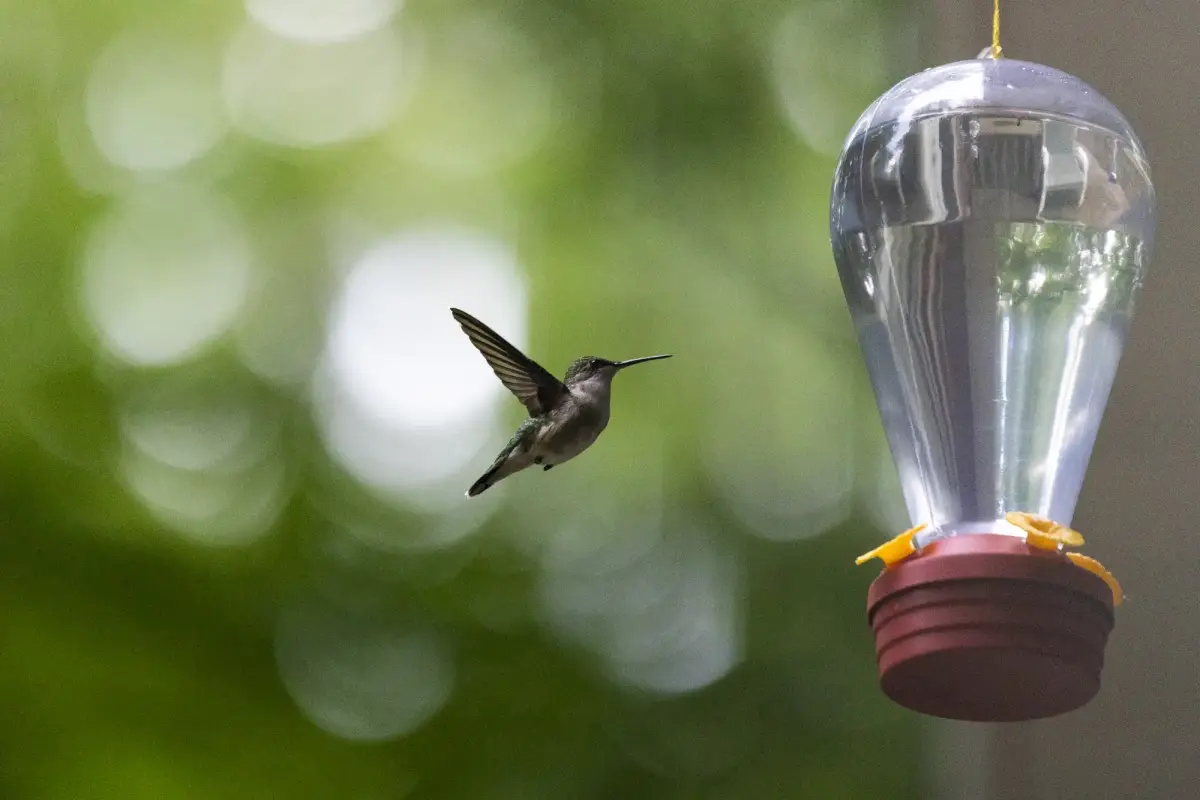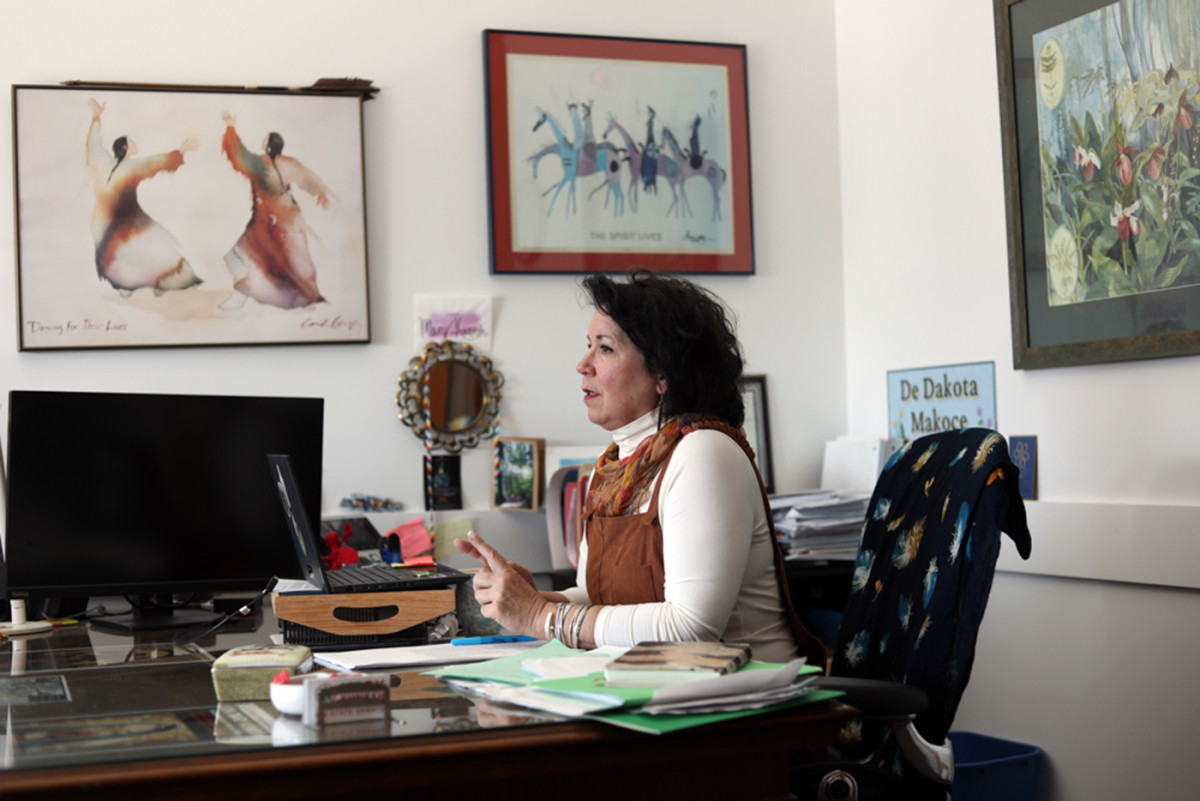News Based on facts, either observed and verified directly by the reporter, or reported and verified from knowledgeable sources.
Restored tribal land ends uncertainty for a family
 Mille Lacs Band of Ojibwe District 1 Representative Virgil Wind, Deanna Wilson Fredrickson and Commissioner of Natural Resources Kelly Applegate look out over Mille Lacs Lake from Band elder Dixie Kamimura’s home in Onamia, Minnesota on June 24. (Liam James Doyle for MPR News)
Mille Lacs Band of Ojibwe District 1 Representative Virgil Wind, Deanna Wilson Fredrickson and Commissioner of Natural Resources Kelly Applegate look out over Mille Lacs Lake from Band elder Dixie Kamimura’s home in Onamia, Minnesota on June 24. (Liam James Doyle for MPR News)
It’s taken at least four decades for Minnesota to resolve who holds title to the land within the Mille Lacs reservation
The restoration of 18 acres on the south side of Mille Lacs Lake means an end to decades of uncertainty for one family.
A bill passed by the state Legislature returning the land is not so much an example of “land back” — a phrase which has gained traction from tribal nations in the past few years — but rather a restoration of title to the land. Mille Lacs band members say they never left.
Don Wedll remembers the day almost 40 years ago when one Mille Lacs Band citizen walked into his office distraught. At the time, Wedll served as the commissioner of natural resources for the Mille Lacs Band.
“Melvin Pewaush, who was living on that property, came into my office with a letter from the state department of natural resources claiming that he had to move off of that land because it was public school district lands, and he wasn’t supposed to be there.”
All 18 acres are within the Mille Lacs reservation and have been held in trust by the state.
It’s taken at least four decades for the state to resolve who holds title to the land. With the passage of legislation this spring, the Mille Lacs Band becomes the first tribal nation in the state to see land from the Minnesota Office of School Trust Lands restored by the state Legislature.
The story of this parcel goes back over a century and a half.
At the time of statehood, the federal government granted two sections of land from every township to raise money for public education. Trust lands earn revenue through mining, timber sales or real estate transactions.
The designated sections in every township were numbered 16 and 36.
“And tribal members have lived there not knowing they were in section 16 but lived there since before the reservation was created, and as such, they lived there and that was their home.”
Wedll says a citizen of the Mille Lacs Band has lived there continuously since before school trust lands were created.
Mille Lacs oral history recalls an Ojibwe veteran who lived there around the time of the Civil War who was said to have had a soldier’s script for the land. The house he built is said to have burned down and the Mille Lacs Band was never able to re-establish legal claim to the property.
Curt Kalk is a citizen of the Mille Lac Band and has worked for the band for decades. Kalk is also the great-great-grandson of the veteran.
“Keg-gway-dosay served like an ogichidaa which would be a kind of servant or a leader or a kind of service person within the tribe,” said Kalk.
Kalk says the relationship between his great-great-grandfather and the land on Mille Lacs Lake where he once lived continues into the present.
“One of the things that’s important is that he’s buried there on this piece of property that we’re talking about,” said Kalk.
Kalk heard those stories growing up with his grandmother Maude Kegg — a Mille Lacs elder who worked alongside Harvard linguist John Nichols documenting Ojibwe language and lifeways toward the end of her life. Kalk says he lived with his grandmother listening to those stories about the property where Keg-gway-dosay lived.
“Pay attention to what your elders say about it,” said Kalk. “So, I am just learning about it then as a kid. There are artifacts that are supposed to be there. There are graves there.”
Returning school trust lands
In the 40 years since Melvin Pewaush first received a letter from the DNR asking him to vacate the land, there have been several ideas on how to resolve the matter, but each failed — until this year.
State Sen. Mary Kunesh, DFL-New Brighton, sponsored the legislation that restored title to the Mille Lacs Band. She’s a descendant of Standing Rock Sioux Tribe, a tribal nation in North and South Dakota. She helped introduce several pieces of legislation proposing the return of land to tribes during the most recent session.
Kunesh says her office took the parcel’s status as school trust land into consideration.
According to research done by her office, the parcel had not earned significant revenue for the school trust fund in many years.

Kunesh notes the legislation passed this spring allocates money to the state’s school trust fund.
“The state purchased those acres and then used those dollars, $750,000, into the school trust fund that would continue to build the corpus so we could increase the dollars that go to the students,” said Kunesh.
Not everyone was in support of restoring title to the tribe.
Mille Lacs County Board of Commissioners says there is no evidence of tribal grave sites on the land. The county board says it believes those claims have been used to justify what they call an “unjust land transfer.”
A news release from the Mille Lacs County administrator went on to state the public sale of the land should have benefitted the school trust and the county. The statement also asserted that the transfer sets an “alarming precedent.”
There are over 175,000 acres of school trust lands within reservation boundaries across the state.
‘Protected by our people for a long time’
Dixie Kamimura, a Mille Lacs Band elder, is the most recent member of the Pewaush family to live on the restored land.
The shoreline along Mille Lacs Lake where Kamimura lives with her family is dotted with bulrushes. Birdsong fills the canopy of basswood and maple trees above her two-bedroom home.
Kamimura’s daughter DeAnna Wilson Fredrickson, along with members of Mille Lacs Band leadership recently visited Kamimura in her living room trading stories.
Wilson Fredrickson asked her mother, who is now in her 70s, if she had been born in one of the small houses that used to stand near the house she lives in today.
Wilson Fredrickson shares her own memories of visiting her great-uncle Melvin when she was a kid.
“I would get out of the car and these chickens would start chasing me,” recalls Wilson Fredrickson. “And I would be running around the car in circles, and Soo Line would be standing there laughing. And I’d go, “Make them stop!’ And he goes, ‘Stop running then!’ And I couldn’t stop running!” laughed Wilson Fredrickson.

Her uncle Melvin Pewaush, who passed away years ago, was the same man the DNR asked to vacate the land in the 1980s. Kamimura and Wilson Fredrickson refer to Melvin by his nickname “Soo Line,” a name that came from his love for trains.
Kamimura says Soo Line was respected by people who lived around Mille Lacs Lake for his knowledge of Ojibwe lifeways.
“Even the doctors from the Nay-ah-shing Clinic, because they were so interested in our way of life when it came to the medicines and healing people, they also came to a couple of sweats through my uncle,” remembered Kamimura.
Outside of Kamimura’s house, there are features on the land that recall the family’s history as healers. A group of large rocks suggests a sweat lodge may have been constructed nearby.
“You could call him a pharmacist. He gathered all the medicines that were needed,” said Kamimura.
Mille Lacs Band of Ojibwe’s commissioner of natural resources Kelly Applegate says the restoration of the land’s title will allow his agency stewardship.
“We can best manage that to fit into the landscape here that is Mille Lacs Lake. We’re very concerned about the environment, so we’ll protect that land,” said Applegate.
Visiting Kamimura and her daughter at their home, Applegate points out an abundance of medicinal trees and plants. He pauses to point out a large white cedar tree near the driveway to Kamimura’s house.
“This is a very old tree,” explained Applegate. “This tells me that this tree has been protected by our people for a long time. Certainly, this tree has been used for medicine. That’s got to be a hundred and fifty to two hundred years old.”
Applegate says resolving issues related to the land’s title will also allow the Mille Lacs Band to provide elder services to Kamimura.
Kamimura says she could use the band’s help to fix her well.
“Especially with the water, it’s so limited at this time what I can do here,” said Kamimura. “If everything is fixed, or [the Mille Lacs Band] can fix the water and everything, I can even have a washer and dryer. That would be amazing,” said Kamimura.
Despite the challenges, Kamimura says she feels good every morning she spends in her home.
“I just love it up here. I really do … When I go out and put tobacco out and everything, I feel a lot of really good feelings.”
She says she knows her Uncle Melvin would be glad their family will remain on the land for years to come.

